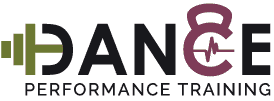Fix It Friday will feature common injuries/difficulties in dancers with a few tips to improve or prevent them!
Phase 1 of our simple starter guide to help if you have mild hamstring strain symptoms!
Hamstring strains are a very prevalent injury in dance & all sports. If it’s too minor for you to seek further medical care or want a few extra exercises, here’s some we use to treat early on. Though we want to limit aggravating the symptoms the first week or two, especially the first 2-3 days, so this is all as tolerated without increased pain. Tune in 2 weeks from now for the second phase.
Bridges/Bridges on Roller: You’ve seen them before. They’re a great glute exercise but also mostly isometric on the hamstrings. Focus on slow movement with holds. If easy & no pain, add a roller to increase the challenge to hamstring. Don’t overload it. 10-20 reps with 5 sec hold as it gets easier.
Wide Stance RDL: After you get comfortable with isometrics we can move into very small range eccentrics (lengthening). Start light & work up to moderate weights as able, using your hip hinge pattern to very slowly lower the weight between your feet. Spine is straight to keep tension on hamstrings. Go down until just prior to increasing pain. Use other leg to raise up. As easier, add holds up to 10 secs. Range should improve over time. 8-12 reps.
Hamstring Rolling: Though studies cont to show rolling doesn’t do all we thought, it does help relieve muscle soreness. Not much is needed, as little as 30 secs can produce results. For purely analgesic effect, we typically go up to a min, 1-2 times per day, moving more weight on to the hamstring as tolerated.
Every exercise should feel hard, but not impossible. Start with higher reps, then as able, increase resistance as get into the lower rep range.
Repeat these exercises 3 times 3-4 days a week. Can decrease to 2-3 times per week when feeling better and incorporate them into phase 2 once all feeling good and allowed a couple weeks for recovery. If pain is already very high, unlikely a few new exercises will help, you likely need a more specialized program.
This is not medical advice. This is general exercises performed for this condition. Please seek professional advice for injuries or pain persisting over time. If general exercise gives you pain, you likely need more specific and direct attention. Take care of your body.
To keep up with our vides, follow along here or on any of our social media platforms.
Scott DPT
#BeyondCrunchesandPilés








